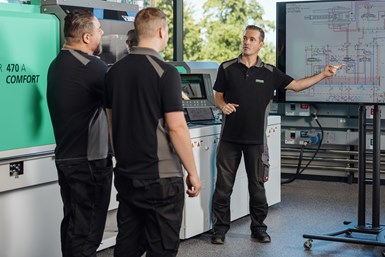Five Ways to Increase Productivity for Injection Molders
Sponsored ContentFaster setups, automation tools and proper training and support can go a long way.
Share
We are all under pressure to do more with less every year. In essence this is what makes a business successful in the long term. This is true for any business and for any activity – getting better and more efficient in what we do.
In plastics injection molding, productivity is gauged by how many good, saleable parts you can produce using the equipment, materials and people you have in your manufacturing plant or plants. Adding people or equipment without trying to do more with less isn’t a winning business proposition.
For injection molders in today’s highly competitive plastics market, the key to increasing productivity lies in getting more good parts using the machines, the materials and the people you have available to you. Let’s look at five ways Arburg can help you do that.
1) SET UP FASTER
Setting up an injection molding machine and getting it to the point where it is reliably producing good parts at the highest possible rate is a complex process that is made more difficult by time pressures, tight quality requirements and a general lack of skilled workers. This last factor is key because there is a certain level of experience and process knowledge needed to set initial pressures, speeds, temperatures, etc., to get the mold running, and even more to “dial it in” for best quality, cycle time and overall efficiency.
Fortunately, a lot of that knowledge and experience has been captured in so-called “expert” programs like the aXw Control FillAssist built into the Gestica controller. Starting from a 3D part model, this intelligent control function simulates mold filling as a function of the screw stroke and determines process parameters – injection speeds for example – that are appropriate for the machine and the process. FillAssist animates the filling process in 3D graphics on the operator interface screen so the user can view the filling level of the part in relationship to screw position in real time. Parameters, such as cylinder temperatures and mold-clamping force, can be transferred directly to the mold-setting data record. This benefits even experienced operators since they can transfer the parameters to production level with a single click while concentrating on optimizing the cycle.
2) APPLICATION ENGINEERING SUPPORT
The pool of knowledge that human operators and technicians bring to injection molding is one of the most vital resources a company has. However, facilities can supplement their teams with engineers and products offered by Arburg.
In the end, however, final decisions fall to human operators and technicians, and when it comes to more challenging materials and applications, the human brain is still required, if only to double-check the recommendations of an automated assistant. Here again, the shortage of experienced, knowledgeable technicians comes into play. Even the biggest molders are short-staffed when it comes to application engineering and that’s a significant issue as applications become more complex and more specialized materials are used.
However, there is a resource available with a pool of knowledge unequaled in the industry. Collectively, Arburg applications specialists have hundreds of years of experience and access to all the latest equipment and technology. From component design and material selection to machine configuration and production optimization, they can find the most efficient solution to productivity challenges. For instance, cube mold technology can increase production of multi-material components by up to 200% compared to more conventional techniques. For high-speed packaging applications, hybrid machine technology is the solution. The servo-electric power train cycles faster and cut energy use, while in thin-wall packaging components, the powerful hydraulic drives achieve high pressures while maintaining precision and shortest possible cycle times. Recycled materials can also be a real challenge due to their variability and Arburg engineers can show you how to achieve high-production levels with consistent quality. In fact, for every process and material – for example liquid-silicone or clean-room operations – the Arburg application engineering team knows how to apply modern manufacturing technologies for maximum productivity.
3) TURNKEY AUTOMATION
It seems the shortage of labor, both skilled and unskilled, keeps coming up, and there is no question that molders today cannot find enough of the employees they need. Automation is certainly an answer because, if you no longer need a human operator to handle the parts coming out of your machine, the labor shortage is no longer a problem. But automation can offer so much more to support your quest for increased productivity. Consider the following:
- More consistent cycles… When you no longer have human variability involved in each cycle, your cycles will inevitably become more consistent, and production goes up. Machines are designed for repetitive operations, so the elimination of variability also will result in more stable processing conditions and more consistent quality, even when producing highly complex products.
- Better production information… When machine operation is more stable and repetitive, molders have an easier time accurately identifying operating costs, and forecasting and scheduling production output. Overall equipment effectiveness (OEE) is improved.
- Value added… The benefits of automation can extend way beyond parts molding. Adding a robot (or more than one), along with other secondary operations in a carefully designed molding cell makes it possible to do more value-added operations right at the molding machine. This moves secondary manufacturing operations out of the customer’s plant (reducing their costs and increasing efficiency) and into the molder’s plant, where they can increase profitability.
- More sustainable… Automated molding and manufacturing is inherently more space and energy efficient. When you don’t need to provide for the movement of operators around the molding machines, cells can be designed more compactly for better utilization of plant space. With more operations taking place in one cell, there is less wasted motion (and energy) used to shift parts to and from warehouses and secondary production sites.
Of course, you can design and install your own automated molding cell if you have the engineering staff and related resources to do it. On the other hand, Arburg develops several hundred such cells every year, so they have the experience and the knowledge to exactly meet your needs. Each cell is assembled and tested in Arburg facilities before shipment so it can be installed in your plant quickly and with minimal disruption to on-going production, and start-up goes off without a hitch.
4) STAY UP AND RUNNING
Your equipment is productive only when it is running at peak performance. Predictive maintenance programs can avoid costly unplanned shutdowns and, when the unexpected does happen, timely response is critical. Increasingly, human resources and cost constraints make it difficult for molders to have the personnel available to perform the necessary work, whether preventive or emergency in nature.
Arburg can help with multiple support options. Service hotlines can provide immediate troubleshooting assistance and with Arburg Remote Service (ARS) an encrypted data connection with your equipment provides you with a remote diagnosis and solution, quickly and efficiently. Rapid on-site assistance is provided by a highly trained service and sales network in over 100 countries worldwide. Predictive maintenance, oil management and regular calibration are all available with a service contract.
The ArburgXworld Customer Portal gives molders instant access to a wide range of digital services. The free Basic version gives molders a comprehensive overview of the Arburg machine fleet, online access to the spare parts shop, and quick, easy, 24/7 communication with service technicians or application-technology staff. The Basic package also lets you track spare parts deliveries, view scheduled service appointments, analyze machine malfunctions and access suggested solutions to machine-controller messages.
5) GET A DIGITAL ASSIST
The controls for machines and devices used in injection molding have been mostly digital – rather than analog – for decades, but the full realization of digitalization is really just beginning and artificial intelligence has the potential to revolutionize the way molding machines are set up and operated. The mold-filling simulation system described in #1 is one example, and the service assistant just mentioned in #4 – which makes it easier to diagnose machine malfunctions and identify required repair parts – is another.
Arburg is continually refining the “smartness” of its machines and its ArburgXworld assistant programs help molders fine-tune their equipment for cost savings and productivity improvements.
- aXw Control EnergyAssist, for instance, automatically heats up and deactivates the cylinder module and mold in a uniform and controlled manner depending on the operating schedule of the machine. Thermal decomposition of the material or damage to the hot runner are reliably prevented.
- aXw Control MeltAssist automatically recognizes plasticizing capacity utilization and residence times so material preparation can be quickly evaluated and optimized, and sources of error eliminated. In addition, the running performance (screw stroke and throughput) and load (pressures, temperatures, etc.) of the plasticizing process are also stored in the module.
- aXw Control CycleAssist logs current times of each cycle step and compares them to previously defined reference values, broken down in detail according to start, delay and running time. This makes it easy to identify unproductive time segments.
CONCLUSION
To maximize injection molder productivity, the entire production process and all the variables – from plant and product design to machine operation and maintenance – need to be considered. Each area offers the potential to reduce costs while increasing output and to do so on a sustainable basis. There’s no single solution, however, and every molder must find his own path, supported by partners, such as Arburg, with extensive know-how and state-of-the-art tools.
> Discover what makes ARBURG more than a machine here


